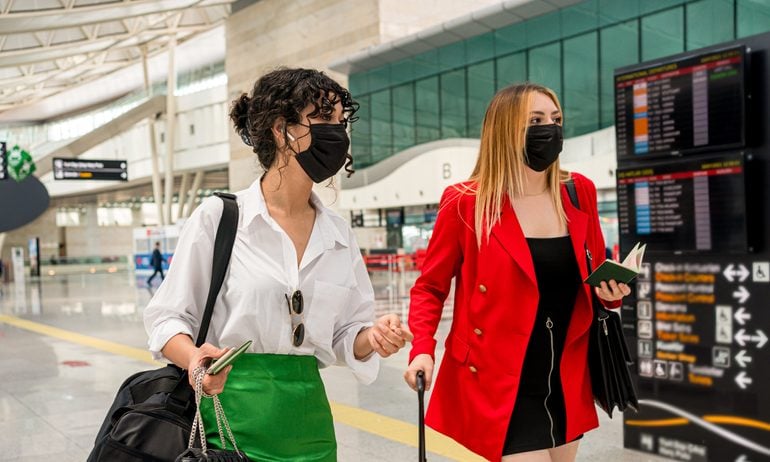Visa vs. Passport: What’s the Difference?
You'll almost always need a passport to travel abroad. Whether or not you need a visa depends on your destination.

Many or all of the products on this page are from partners who compensate us when you click to or take an action on their website, but this does not influence our evaluations or ratings. Our opinions are our own.
You probably know that you need a passport for international travel, but you may have also heard of another type of travel document called a visa. Depending on your travel plans, you might be able to travel with just a passport — or you might need to apply for a visa as well.
But what is the difference between a visa and a passport? Here’s what you need to know.
What is a passport?
A passport is a specific type of official identity document used for international travel. A country's government issues the document to its citizens or in some cases, to noncitizen nationals. Passports contain identifying information like your name, birth date, gender, photo and passport number.
Many passports also contain electronic chips that store your identity information and signature digitally, which makes the passport difficult to fake or alter.
Most passports are regular, or tourist, passports. In the U.S., these are the blue passports that you’re most likely familiar with. But countries also issue diplomatic and official passports for officials traveling on government business.
When do you need a passport?
If you plan to travel internationally, you most likely need a passport. There are alternatives to passports for U.S. citizens going to Canada or Mexico by land, but most international travel will require a passport. International air travel always requires a passport.
» Learn more: Passport book vs. card: 4 key differences
What is a visa?
A visa is a document that permits you to enter another country for a specific length of time and purpose. Whether a visa is required to enter a country depends on your country of citizenship, your reason for travel, the duration of your stay and other factors.
Any country might issue dozens of different types of visas. It may have a complicated taxonomy of visa types or offer only a handful of visa types. Here are some of the most common types of visas:
Tourist visas are issued when you are traveling to a country for sightseeing, visiting friends or other noncommercial, nonofficial purposes. These visas are typically issued for a short stay of a few months.
Student visas are issued to those who will be studying in the country. They typically allow you to stay in a country during your studies, but there are often restrictions on how much you can work.
Work visas allow you to enter a country for the purposes of employment. Most countries require a specific work visa if you want to work during your stay.
Transit visas are issued when you need to pass through a country to catch a connecting flight. Transit visas are typically valid for a short period of time, and visa holders aren’t allowed to exit the airport while in the country.
» Learn more: How to get your first passport
How do you get a visa?
Countries that require a visa will often ask you to send your passport to an embassy or consulate before you travel. Requirements vary, but you will usually be asked to provide evidence of your travel bookings, a photograph, a completed visa form and proof of residence. Visa processing may take a few days to more than a month.
Even if a country requires a visa for travel, you don’t always have to apply for it in advance. Some countries will grant you a tourist visa on arrival. Egypt, for example, grants a 30-day tourist visa to U.S. citizens arriving by air for a $25 fee.
Finally, some countries allow you to apply for a visa electronically. Australia, for instance, allows U.S. citizens, as well as those from a handful of other countries, to obtain an Electronic Travel Authority. You can apply for the electronic visa online, allowing you to get a visa without submitting your passport to an embassy or consulate.
When do you need a visa?
Whether you require a visa for travel will depend on your citizenship, the country you are traveling to, your purpose for travel, and how long you intend to stay.
If you’re a U.S. citizen, one way to find out if you need a visa to travel is to use the State Department’s Learn About Your Destination tool, which contains visa information for most countries. Keep in mind that visa rules can change, so it’s best to verify entry requirements even if it’s a country you’ve been to in the past.
» Learn more: Places to travel without a passport this summer
Visa and passport differences
Here’s a quick overview of the differences between a passport and a visa:
Passport | Visa | |
|---|---|---|
Document purpose | Identity verification. | Permission to visit a country. |
Issuing authority | Your country of citizenship or nationality. | The embassy or consulate of the country to which you are traveling. |
When it is needed | When traveling internationally, with limited exceptions. | When traveling to a country that requires a visa or when traveling for a reason that requires a visa. |
Validity | Usually valid for 10 years, though validity times vary. | Often valid for the duration of your permitted stay, but may be valid for longer periods. |
Visa vs. passport recapped
A passport is for identity verification, while a visa permits you to enter a country.
If you’re traveling internationally, you’ll need a passport. In addition to your passport, some countries require you to apply and be approved for a visa in advance of your travel.
You might also need a visa if you’re traveling for a specific nontourism purpose, such as work or study.
How to maximize your rewards
You want a travel credit card that prioritizes what’s important to you. Here are some of the best travel credit cards of 2025:
Flexibility, point transfers and a large bonus: Chase Sapphire Preferred® Card
No annual fee: Wells Fargo Autograph® Card
Flat-rate travel rewards: Capital One Venture Rewards Credit Card
Bonus travel rewards and high-end perks: Chase Sapphire Reserve®
Luxury perks: The Platinum Card® from American Express
Business travelers: Ink Business Preferred® Credit Card
Chase Sapphire Preferred® Card
Travel
Dining
🔥 Huge highest-ever bonus on NerdWallet's 2025 Best All-Purpose Travel Rewards Card is back. Don't miss your rare chance to: Earn 100,000 points when you spend $5,000 on purchases in the first three months. That's worth at least $1,250 toward travel booked through Chase.


